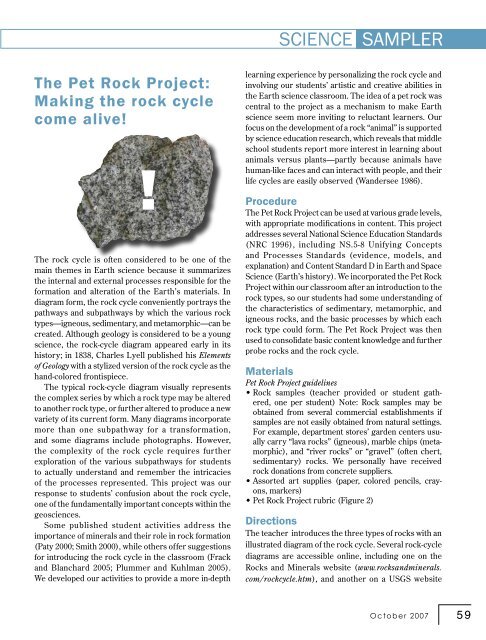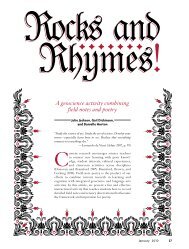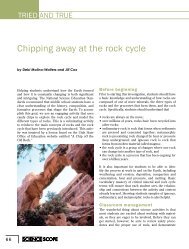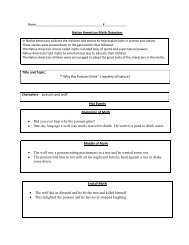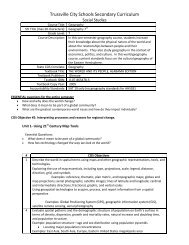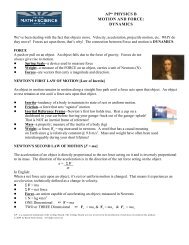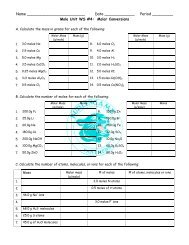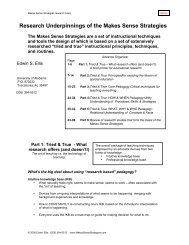The Pet Rock Project - NSTA Learning Center
The Pet Rock Project - NSTA Learning Center
The Pet Rock Project - NSTA Learning Center
Create successful ePaper yourself
Turn your PDF publications into a flip-book with our unique Google optimized e-Paper software.
SCIENCE SAMPLER<br />
<strong>The</strong> <strong>Pet</strong> <strong>Rock</strong> <strong>Project</strong>:<br />
Making the rock cycle<br />
come alive!<br />
!<br />
<strong>The</strong> rock cycle is often considered to be one of the<br />
main themes in Earth science because it summarizes<br />
the internal and external processes responsible for the<br />
formation and alteration of the Earth’s materials. In<br />
diagram form, the rock cycle conveniently portrays the<br />
pathways and subpathways by which the various rock<br />
types—igneous, sedimentary, and metamorphic—can be<br />
created. Although geology is considered to be a young<br />
science, the rock-cycle diagram appeared early in its<br />
history; in 1838, Charles Lyell published his Elements<br />
of Geology with a stylized version of the rock cycle as the<br />
hand-colored frontispiece.<br />
<strong>The</strong> typical rock-cycle diagram visually represents<br />
the complex series by which a rock type may be altered<br />
to another rock type, or further altered to produce a new<br />
variety of its current form. Many diagrams incorporate<br />
more than one subpathway for a transformation,<br />
and some diagrams include photographs. However,<br />
the complexity of the rock cycle requires further<br />
exploration of the various subpathways for students<br />
to actually understand and remember the intricacies<br />
of the processes represented. This project was our<br />
response to students’ confusion about the rock cycle,<br />
one of the fundamentally important concepts within the<br />
geosciences.<br />
Some published student activities address the<br />
importance of minerals and their role in rock formation<br />
(Paty 2000; Smith 2000), while others offer suggestions<br />
for introducing the rock cycle in the classroom (Frack<br />
and Blanchard 2005; Plummer and Kuhlman 2005).<br />
We developed our activities to provide a more in-depth<br />
learning experience by personalizing the rock cycle and<br />
involving our students’ artistic and creative abilities in<br />
the Earth science classroom. <strong>The</strong> idea of a pet rock was<br />
central to the project as a mechanism to make Earth<br />
science seem more inviting to reluctant learners. Our<br />
focus on the development of a rock “animal” is supported<br />
by science education research, which reveals that middle<br />
school students report more interest in learning about<br />
animals versus plants—partly because animals have<br />
human-like faces and can interact with people, and their<br />
life cycles are easily observed (Wandersee 1986).<br />
Procedure<br />
<strong>The</strong> <strong>Pet</strong> <strong>Rock</strong> <strong>Project</strong> can be used at various grade levels,<br />
with appropriate modifications in content. This project<br />
addresses several National Science Education Standards<br />
(NRC 1996), including NS.5-8 Unifying Concepts<br />
and Processes Standards (evidence, models, and<br />
explanation) and Content Standard D in Earth and Space<br />
Science (Earth’s history). We incorporated the <strong>Pet</strong> <strong>Rock</strong><br />
<strong>Project</strong> within our classroom after an introduction to the<br />
rock types, so our students had some understanding of<br />
the characteristics of sedimentary, metamorphic, and<br />
igneous rocks, and the basic processes by which each<br />
rock type could form. <strong>The</strong> <strong>Pet</strong> <strong>Rock</strong> <strong>Project</strong> was then<br />
used to consolidate basic content knowledge and further<br />
probe rocks and the rock cycle.<br />
Materials<br />
<strong>Pet</strong> <strong>Rock</strong> <strong>Project</strong> guidelines<br />
• <strong>Rock</strong> samples (teacher provided or student gathered,<br />
one per student) Note: <strong>Rock</strong> samples may be<br />
obtained from several commercial establishments if<br />
samples are not easily obtained from natural settings.<br />
For example, department stores’ garden centers usually<br />
carry “lava rocks” (igneous), marble chips (metamorphic),<br />
and “river rocks” or “gravel” (often chert,<br />
sedimentary) rocks. We personally have received<br />
rock donations from concrete suppliers.<br />
• Assorted art supplies (paper, colored pencils, crayons,<br />
markers)<br />
• <strong>Pet</strong> <strong>Rock</strong> <strong>Project</strong> rubric (Figure 2)<br />
Directions<br />
<strong>The</strong> teacher introduces the three types of rocks with an<br />
illustrated diagram of the rock cycle. Several rock-cycle<br />
diagrams are accessible online, including one on the<br />
<strong>Rock</strong>s and Minerals website (www.rocksandminerals.<br />
com/rockcycle.htm), and another on a USGS website<br />
O c t o b e r 2007 5 9
SCIENCE SAMPLER<br />
FIGURE 1<br />
<strong>Pet</strong> <strong>Rock</strong> <strong>Project</strong> directions<br />
1. Your assignment is to find a rock—igneous,<br />
sedimentary, or metamorphic—that you wish to<br />
“adopt.”<br />
2. You may turn in your rock “as is,” or you may alter your<br />
rock in a number of ways to personalize it. However,<br />
at least part of the original rock’s surface must be<br />
visible.<br />
3. When you turn in your pet rock, please also turn in a<br />
paper that answers the following questions:<br />
• Where and when did you find this rock?<br />
• Why did you choose this rock?<br />
• What type of rock do you have? Why do you think it is<br />
this type?<br />
• Describe any tests or ways you might determine<br />
exactly what type of rock you have.<br />
• Have you altered your rock in any way? If so, describe.<br />
Why have you done this?<br />
• Draw your own version of the rock cycle.<br />
• Locate your pet rock on the rock cycle.<br />
• Describe how YOUR rock could possibly be transformed<br />
into the other rock types on your rock-cycle diagram.<br />
Your pet rock is due on ________ by the end of class.<br />
(http://3dparks.wr.usgs.gov/nyc/common/geologicbasics.<br />
htm). Students are asked, “Can one type of rock form<br />
the other types of rocks?” and “Can a rock of a certain<br />
type form a new rock of the same type?” <strong>The</strong> teacher<br />
encourages students to describe the rocks they encounter<br />
in their daily lives. We have used the “Geological Sense<br />
of Place” writing template activity (Clary and Wandersee<br />
2006) to probe students’ childhood memories and<br />
experiences with rocks and Earth processes. Students<br />
can also be grouped, and asked to explain the statement,<br />
“Your house comes out of a mine.” Each group produces<br />
a cooperative list of household materials that originate<br />
as rocks or minerals.<br />
Teachers may explore, as a historical-cultural<br />
option, the concept of pet rocks that was developed<br />
by Gary Dahl as a marketing gimmick in 1975. As<br />
the perfect undemanding “pet,” these rocks became<br />
a commercial success, and made Dahl a millionaire<br />
(Polson Enterprises 2006). Students may be divided<br />
into cooperative learning groups, and investigate the<br />
historical, political, and cultural context into which the<br />
pet rock marketing success evolved. Each group can<br />
identify the favorable characteristics of “pet rocks,” the<br />
probable “roles” these “pets” fulfilled in their owners’<br />
lives, and hypothesize whether a similar marketing<br />
gimmick would be successful today. Creativity in the<br />
construction of pet rocks can be demonstrated through<br />
various websites that have used decorated rocks as<br />
fund-raisers (www.uwlax.edu/geography/html/<strong>Pet</strong>-<strong>Rock</strong><br />
Making.htm), and as hands-on activities within<br />
English classes for speakers of other languages (www.<br />
mrshurleysesl.com/petrocks.html). Introduction of these<br />
rock projects to students when the project is first<br />
assigned can illustrate the range of possibilities for the<br />
<strong>Pet</strong> <strong>Rock</strong> <strong>Project</strong>, and also reassure reluctant learners<br />
that creativity within the project is not difficult.<br />
<strong>The</strong> original <strong>Pet</strong> <strong>Rock</strong> <strong>Project</strong> comprised a two-week<br />
period of rock-finding, investigating, and reporting.<br />
Figure 1 summarizes the original handout for the<br />
project. We think that within a typical middle-level<br />
class that meets daily, the <strong>Pet</strong> <strong>Rock</strong> <strong>Project</strong> should be<br />
allotted a five-day period for location and development<br />
of a rock sample, preferably with a weekend available<br />
for students to initially collect their rock samples. <strong>The</strong><br />
rubric utilized in scoring the projects is also provided<br />
to students (Figure 2).<strong>The</strong> teacher directs students<br />
to locate a rock outside of the classroom, and identify<br />
the rock as igneous, sedimentary, or metamorphic.<br />
(Alternatively, the instructor may bring in a bucket of<br />
known rocks, and allow students to choose a favorite<br />
to use in this project. Teacher-supplied rocks would<br />
shorten the required time for the activity; we feel a<br />
minimum of three classroom days would be appropriate<br />
in this situation. Whereas we personally like the idea of<br />
students procuring their own rocks, we acknowledge<br />
that in some schools this may present a problem for the<br />
majority of students.)<br />
Students may decorate or embellish their pet rocks,<br />
as long as some of the original rock material is left<br />
unaltered and exposed. Students then develop their<br />
own version of the rock cycle, and locate their rock<br />
within the rock cycle. Students have a variety of options<br />
in which to create a rock cycle, including an electronic<br />
6 0 SCIENCE SCOPE
SCIENCE SAMPLER<br />
FIGURE 2<br />
<strong>Pet</strong> <strong>Rock</strong> <strong>Project</strong> rubric.*<br />
Student name ___________________<br />
CATEGORY 10 8 6 4<br />
Required<br />
elements<br />
<strong>The</strong> project includes<br />
all required elements<br />
as well as additional<br />
information.<br />
All required<br />
elements are<br />
included in the<br />
project.<br />
All but one of the<br />
required elements<br />
are included in the<br />
project.<br />
Several required<br />
elements are<br />
missing.<br />
Explanatory<br />
paragraph:<br />
Accuracy<br />
At least four accurate<br />
facts are displayed.<br />
Three accurate facts<br />
are displayed.<br />
Two accurate facts<br />
are displayed.<br />
Less than two<br />
accurate facts are<br />
displayed.<br />
Originality<br />
Several of the<br />
components reflect an<br />
exceptional degree of<br />
student creativity in<br />
their construction or<br />
display.<br />
One or two<br />
components used<br />
reflect student<br />
creativity in their<br />
creation or display.<br />
<strong>The</strong> components are<br />
made by the student,<br />
but are based on the<br />
designs or ideas of<br />
others.<br />
No components<br />
made by the student<br />
are included.<br />
Graphics<br />
Attractiveness<br />
All components are<br />
related to the topic<br />
and make it easier<br />
to understand.<br />
All borrowed<br />
components have a<br />
source citation.<br />
<strong>The</strong> project is<br />
exceptionally<br />
attractive in terms of<br />
design, layout, and<br />
neatness.<br />
All components<br />
are related to the<br />
topic and most<br />
make it easier<br />
to understand.<br />
All borrowed<br />
components have a<br />
source citation.<br />
<strong>The</strong> project is<br />
attractive in terms of<br />
design, layout, and<br />
neatness.<br />
All components<br />
relate to the topic.<br />
Most borrowed<br />
components have a<br />
source citation.<br />
<strong>The</strong> project is<br />
acceptably attractive<br />
though it may be a<br />
bit messy.<br />
Components<br />
do not relate<br />
to the topic OR<br />
several borrowed<br />
components do<br />
not have a source<br />
citation.<br />
<strong>The</strong> project is<br />
distractingly messy<br />
or very poorly<br />
designed. It is not<br />
attractive.<br />
* This rubric may be modified according to the background and skills of the student population, and the extent of the investigation<br />
of the rock cycle in the classroom.<br />
version, a collage, a poster, or a plain-paper version.<br />
Students may use website images, their textbooks, or<br />
photographs from magazines or journals. All outside<br />
materials, whether from the internet or paper journal,<br />
should be cited by students. (We assume that the<br />
teacher has provided basic directions to students on<br />
how to conduct internet searches, including information<br />
on image searches and reliability of websites, before<br />
students are encouraged to use the internet.) Although<br />
these activities were originally assigned as out-of-class<br />
assignments, they can easily be incorporated into the<br />
traditional classroom. In addition to producing their pet<br />
rock, students develop a written report justifying the<br />
identification of their rock, and describing how their pet<br />
may be turned into the other types of rocks. Creativity<br />
is encouraged.<br />
O c t o b e r 2007 6 1
SCIENCE SAMPLER<br />
FIGURE 3<br />
One student participating in the <strong>Pet</strong> <strong>Rock</strong> <strong>Project</strong> chose a common piece of Mississippianage<br />
chert as her adopted rock. Modifications include the addition of cardboard legs, tail, and<br />
head to create a camel.<br />
A. B.<br />
photos courtesy of the authors<br />
FIGURE 4<br />
“Slick,” a piece of obsidian, was<br />
personalized with the addition<br />
of formal attire<br />
Discussion and findings<br />
We were pleasantly surprised and impressed by the variety<br />
of <strong>Pet</strong> <strong>Rock</strong> <strong>Project</strong>s that we received. Most of the rocks<br />
students submitted were samples of chert gravel, used<br />
locally to build roads. However, many students creatively<br />
embellished their rocks, or added props or features<br />
(Figure 3), and some of the pet rocks submitted were<br />
collected by students outside of the state (Figure 4).<br />
One of our favorite submissions was scoria, a<br />
volcanic rock often used for landscaping. <strong>The</strong> student<br />
named her rock “Dat” (Figure 5) in honor of the New<br />
Orleans Saints, and creatively relayed the story of how<br />
this “football rock” could be transformed into other<br />
rock types (Figure 6). Although the student incorrectly<br />
identified her rock as pumice, the stor y reveals<br />
incredible creativity as well as an understanding of<br />
the internal and external processes that operate on<br />
the surface of and within Earth.<br />
Student-created rock cycles also exhibited<br />
understanding of the interrelatedness of igneous,<br />
sedimentary, and metamorphic rocks. Some students<br />
produced their rock-cycle diagrams by drawing, some<br />
students created rock-cycle diagrams electronically, and<br />
some students fashioned rock-cycle diagrams with shape<br />
cut-outs. Three examples of student rock cycle diagrams<br />
are presented in Figure 7.<br />
6 2 SCIENCE SCOPE
SCIENCE SAMPLER<br />
FIGURE 5<br />
“Dat,” a piece of scoria, was<br />
altered only by the addition of<br />
his “team symbol.” <strong>The</strong> rock’s<br />
story and relationship within<br />
the rock cycle are presented in<br />
Figure 6.<br />
FIGURE 6<br />
Student submission of pet rock<br />
relationships. This story exhibits<br />
a higher level of creativity than<br />
typical student submissions.<br />
Conclusion<br />
Students may often encounter so many facts, concepts,<br />
and theories in a science class that they exit the class at<br />
the end of the year with only a skeletal understanding of<br />
isolated scientific principles. Some constructs in Earth<br />
science, such as plate tectonics and the rock cycle,<br />
are unifying themes in the geosciences and deserve<br />
more than a cursory glance by students. Thorough<br />
understanding of these important constructs provides<br />
a knowledge base within Earth science on which<br />
further topics can be linked and scaffolded. We think,<br />
based on students’ submitted projects and anonymous<br />
student survey data, that the <strong>Pet</strong> <strong>Rock</strong> <strong>Project</strong> was<br />
successful in promoting a more in-depth understanding<br />
of the rock cycle. Because the project involves the<br />
“adoption” of a rock, we think that the <strong>Pet</strong> <strong>Rock</strong> <strong>Project</strong><br />
may possibly promote personal meaning-making in the<br />
classroom by targeting students’ affective as well as<br />
their intellectual domains, and giving students multiple<br />
relevant opportunities to retrace and internalize rock<br />
cycles’ subpathways. Furthermore, varying degrees of<br />
content knowledge may be easily incorporated within<br />
the assignment so that it can be implemented at various<br />
grade levels. We encourage other science teachers to<br />
creatively explore the investigation of rock properties<br />
and the rock cycle through the <strong>Pet</strong> <strong>Rock</strong> <strong>Project</strong>.<br />
References<br />
Bybee, R.W., and A.H. Pratt. 1996. National standards: Challenges<br />
for Earth science education. Geotimes 41: 16–19.<br />
Clary, R.M., and J.H. Wandersee. 2006. A writing template<br />
for probing students’ geological sense of place. Science<br />
Education Review 5 (2): 51–59.<br />
Frack, S., and S.A. Blanchard. 2005. <strong>Rock</strong>in’ around the<br />
rock cycle. Science Scope 29 (2): 62.<br />
Lyell, C. 1838. Elements of geology. London: John Murray.<br />
Mantell, G. 1836. Thoughts on a pebble, or a first lesson<br />
in geology. London: Relfe and Fletcher.<br />
Mintzes, J.J., J.H. Wandersee, and J.D. Novak, eds. 1998.<br />
Teaching science for understanding: A human constructivist<br />
view. San Diego, CA: Academic Press.<br />
O c t o b e r 2007 6 3
SCIENCE SAMPLER<br />
FIGURE 7<br />
Students produced their own renditions of the rock cycle, using a variety of media and<br />
techniques. <strong>The</strong> rock cycle on the upper left accompanied “Dat,” the igneous rock,<br />
while the lower left rock cycle is a computer-generated version.<br />
National Research Council (NRC). 1996. National science<br />
education standards. Washington, DC: National Academy<br />
Press. Available online at www.nap.edu/readingroom/books/nses.<br />
Paty, A.H. 2000. <strong>Rock</strong>s and minerals—Foundations of our<br />
society. Science Scope 23 (8): 30–31.<br />
Plummer, D., and W. Kuhlman. 2005. <strong>Rock</strong>s in our pockets.<br />
Science Scope 29 (2): 60–61.<br />
Polson Enterprises. 2006. <strong>The</strong> <strong>Pet</strong> <strong>Rock</strong> page. www.virtualpet.com/vp/farm/petrock/petrock.htm.<br />
Sife, W. 1998. <strong>The</strong> loss of a pet. Hoboken, NJ: Howell Book<br />
House—John Wiley and Sons.<br />
Smith, S. 2000. Turning bread into rocks: A multisensory<br />
unit opener. Science Scope 24 (2): 20–23.<br />
Wandersee, J.H. 1986. Plants or animals: Which do junior<br />
high school students prefer to study? Journal of Research<br />
in Science Teaching 23: 415–26.<br />
Renee Clary (rclary@geosci.msstate.edu) is an assistant<br />
professor of geology in the Department of Geosciences<br />
at Mississippi State University in Mississippi<br />
State, Mississippi. James Wandersee is an endowed<br />
professor of biology education in the Department of<br />
Educational <strong>The</strong>ory, Policy, and Practice at Louisiana<br />
State University in Baton Rouge, Louisiana.<br />
6 4 SCIENCE SCOPE


